On July 12th, over 100 people converged on the
steps of Vallejo City Hall to bring a strong and clear message to City Council, which was holding closed session meeting regarding the future of the sacred burial ground known as Sogorea Te (Glen Cove). Demonstrators arrived an hour before the scheduled meeting, gathering together around the drum to sing before entering the council chambers.
Colorful signs carried messages such as “No bulldozing on sacred ground” and “Protect all 15 acres”, referring to the cultural easement that is currently being negotiated by the city, GVRD, and two federally recognized Patwin tribes that the city has chosen to acknowledge as stakeholders. The details of this draft cultural easement have not been revealed to the public or to the Ohlone and Miwok-led Committee to Protect Glen Cove. Speakers throughout the evening encouraged the city to ratify the easement, with the qualification that in order to meaningfully protect the burial grounds, any agreement must encompass all 15 acres and prohibit bulldozing and development.
Dozens of people signed up on cards to speak before the council, however, only five were permitted to speak in advance of the closed session, which convened at 6:30pm. The rest were instructed to wait until the Community Forum at the end of the 7:00 council meeting if they still wished to speak.
Glen Cove residents Sandra Pacheco, Ray Richardson and Jeff Franklin spoke eloquently in the first session, along with Vallejo residents Marcos Negran and Wounded Knee DeOcampo. In a room packed full of supporters wearing red shirts, Wounded Knee closed his speech with a plea to the council, and to GVRD: “It is time to halt. Enough is enough of desecrating sacred sites and burial grounds of indigenous people.”
Demonstrators patiently sat through almost four hours of City Council discourse on matters such as a proposed tax related to marijuana sales, awaiting the opportunity to further speak about Sogorea Te during the final Community Forum. By the end of the meeting at around 11:30pm, eighteen speakers had shared their deeply held convictions about the need to protect and respect the sacred grounds of Sogorea Te. Late-night speakers included Corrina Gould (Ohlone), Li Pono, Galeson Eaglestar (Oglala Lakota), Michelle Steinberg, Reverend Patrick McCollum, Dr. Barbara McGraw, Antonio Gonzalez (Seri), Sam Kirsham, Perry Matlock, LeRoy Cisneros, Zak Alvarez, Morning Star Gali (Pit River) and Mark Anquoe (Kiowa).
The only response from councilmembers regarding Sogorea Te came from Mayor Osby Davis, in reply to Glen Cove resident Karol Heppe. Ms. Heppe was the one person who spoke in an angry tone about the vigil at Sogorea Te, demanding that the City enforce its park ordinances upon she called a “tent city” occupied by a “unlawful band of people”. The Mayor responded that the council is hoping the cultural easement will be signed by the 26th of this month, and then threatened, “We’re either going to have an easement, or we’re going to give staff direction to enforce the law. That’s the bottom line.”
The 12th was a powerful show of solidarity and unity, in which the demand that indigenous peoples’ sacred grounds be respected was conveyed in a hundred different ways. As we continue to keep up the struggle in honor of the ancestors at Sogorea Te, only time will tell whether the council members took our voices to heart.
Photos from the demonstration:
A collection of photos from July 12th can be found here.
Speaking to City Council: Videos and Transcripts
In total, eighteen people spoke to City Council on July 12th, in support of protecting and respecting all 15 acres of Sogorea Te. Their names are listed in the article above. The following is a selection of video clips from the evening, with transcripts.
- Wounded Knee DeOcampo, Tuolumne Miwok
- Corrina Gould, Karkin/Chochenyo Ohlone
- Galeson Eaglestar, Oglala Lakota Nation
- Ray Richardson, Glen Cove resident & Professor of Ethnic Studies
- Sam Kurshan, Vallejo resident
- Perry Matlock, San Francisco resident & Shellmound defender
- LeRoy Cisneros
- Michelle Steinberg, Protect Glen Cove Committee Volunteer
- Mark Anquoe, Kiowa Tribe, International Indian Treaty Council
- Osby Davis, Mayor of Vallejo
Additional transcripts may be added to this page as we have time to compile them. However, if you are patient enough to sift through it, a recording of the entire council meeting is available on the City Council webpage. (Requires Microsoft Silverlight plugin)
Wounded Knee DeOcampo
Transcription
Greetings. Greetings to the City Council, greetings to the citizens of Vallejo. It is time that we ask the City Council to put a halt to desecrating the sacred burial grounds of our ancestors.
This sacred site is 3,500 years old, dating back to 1,500 BC. My mother was born on the California Indian reservation at Tuolumne, CA. She was a Miwok. She took me to that site when I was a little bitty boy, and told me about that sacred site.
We are asking you, and the citizens of Vallejo, to protect this sacred site. It is very spiritual to Indian people, and we need the help of the citizens of Vallejo to back us, to protect this sacred site.
This sacred site is a home of many, many California tribes that travelled through this area. They came there on their tule canoes, they came there to do their ceremonies, and to trade, and do their vision quests. This is very sacred to us. It’s a 3,500 year old sacred burial ground of our ancestors.
So I ask the City of Vallejo: Are you in violation of Human Rights, are you in violation of Civil Rights, are you in violation of HR 1913, the Hate Act, or are you in violation of a violent act to destroy a sacred burial ground?
There are many many people watching the City of Vallejo and GVRD around the world and around this country. We have many, many supporters [and organizations] who are supporting us to protect this sacred burial ground. And [they include] the American Indian Movement, and other organizations, IPOC [Indian People Organizing for Change], and International Indian Treaty Council, and Greenaction.
We are asking you not to desecrate this sacred site. This is a sacred site of many, many people. My ancestors could be buried down there. And I’m asking the City Council to listen to our cry. Because our ancestors are crying for us to protect that sacred site.
And we need your support, to protect that sacred site. I’m asking you, and pleading with you, and the GVRD. No more desecration. It is time to halt. Enough is enough of desecrating sacred sites and burial grounds of indigenous people. Thank you very much.
Corrina Gould, Chochenyo/Karkin Ohlone
Transcription
(Audio clip w/ better sound than the video above)
Good evening. [speaks in Ohlone] In Chochenyo, my ancestors’ language, I said good evening, my name is Corrina. I’m Chochenyo and I’m also Karkin Ohlone. And I come here today to talk to you about why it is important for the City Council here in Vallejo to consider the easement at Glen Cove or Sogorea Te in its entirety of 15 acres.
There’s a quote that I came across while I was sitting here listening, and you guys have a really long meeting. And it says, “Our lives begin to end the day we become silent about things that matter.” And that was Rev. Dr. Martin Luther King that said that. And its true. And today I stand before you because I really believe in protecting this site.
Over 12 years ago, we became involved in protecting this site that is one of our ancestral burial grounds. And it has become more than just an Indian issue. It’s an issue for the City of Vallejo, it’s an issue for human beings. And the reason I say that I want you guys to think about the easement in the entirety of 15 acres is that while we’ve been doing research here, we have found that there were actually five shellmounds that were in the Glen Cove area. In 1976 when there was a report that was created before any of the homes were built there, there were actually five shellmounds that were there. Four of them were in-tact.
And so, when the building was actually done in the Glen Cove area, four of those shellmounds were desecrated, or they were disturbed, or they were destroyed. The shellmound at Glen Cove is one of 425 that used to ring the Bay Area. And in the last 100 years, all of those shellmounds have been covered over or destroyed.
We have been coming to the City of Vallejo and the Greater Vallejo Recreation District asking for three things to happen, or not to happen, on that land. We don’t want a bathroom, we don’t want a parking lot, and we don’t want the hill graded.
The whole entire site is a place that used to be a village site for our ancestors. Places where freshwater creeks run through, places where we could fish. And people still fish there. Amazingly, when I’ve been out there on the land in the last 90 days we’ve seen fishermen coming up with sturgeon that are as tall as me. People from all over, all over Northern California have come to visit that site. And continue to use it as its been used for the last 4,000 years.
I ask that you consider signing the easement and the MOU [Memorandum of Understanding] with the Federally Recognized tribes that you are in conference with now, and that all of that land is protected. All we’ve been asking for, for the last 10 years is that there’s no bathrooms put on our cemeteries, there’s not a parking lot built. And as we’ve been out there for the last 90 days in a prayerful vigil, we know that we’ve had over 300 people there and there’s no need for [additional] parking.
We also know that if you grade that hill, there will be disturbance of more ancestral remains. And we have been in contact with archeology firms that are willing to take that site and look at it in a different way. We’re also working with canine forensics that are willing to go in there and begin to do some research on how to find the human remains that are left there.
There were many cremations that were done in this area. And because that land thats on that hillside that GVRD wants to grade has already been disturbed, there needs to be consideration that those cremations and burials are not in places where you can do auguring and you’ll be able to find stuff.
We’re asking that those 15 acres be left in-tact as much as possible. That there’s no bathrooms, there’s no grading, and theres no parking lots. [Mayor Osby Davis: Alright, thank you.] mmm.
Galeson Eaglestar, Oglala Lakota Nation
Transcription
[Speaks in Lakota] Greetings. I shake each and every one your hands in a good way. My name’s Galeson Eaglestar, I’m from the Oglala Lakota Nation from South Dakota, and some people are probably wondering why somebody from South Dakota is here supporting a very critical matter regarding a burial site, a cemetery, that is being considered to be desecrated, in the name of parks and recreation.
I have been there off and on in the last 60 days since I came from South Dakota, and I’ve done a lot of soul searching and praying, in the time that I have been there. And its very, very sad. I’ve shed a lot of tears for my sisters, and for the people. I pray for the City of Vallejo, and the Greater Vallejo Recreation District as well, and the people, the leadership. And I can’t even fathom why these human beings decide to desecrate sacred burial sites in the name of developing a park, so that the people, the human beings can walk on these desecrated graves. I don’t understand, as a human being.
But I, I continue to pray, every day. For the human beings, for the betterment of mankind. That these gravesides be left alone. I know the spirits of those ancestors are there. I know they’re cryin’ out, just like we are, today.
I’m only one in this world, but I like to think that instead of a parking lot and a bathroom, and the paved trails, a plaque could have been developed there in the name of our ancestors. We can’t…[Mayor: Your time is expired. You have three minutes, when that red light blinks, your time is up.] We can’t stop the people from walking those walkways as it is in its natural form. I think it should be left alone like that. Nobody’s been complaining about the way it is now. [Mayor: The light is blinking. OK, so your time is up.] …so I hope that people can understand where we’re coming from. Thank you very much, that’s all I have to say.
Ray Richardson, Glen Cove resident and Ethnic Studies Professor
Transcription
Good evening ladies and gentlemen. My name is Ray Richardson, I’m a professor of Social and Behavioral Sciences. I just retired in the California State System as well as the California Community College system. I chaired the Ethnic Studies department, which included African American, American Indian, Asian, and Mexican/Latin studies. And I’ve had the opportunity over 30 years to be able to travel to many of those countries, and many sacred sites.
I’m confused. And I’m confused because I don’t understand how a city like Vallejo, having such a historical site in this city, could even consider the desecration of these grounds.
You know, I wonder what would the action be, if we had said that Columbus in 1492 landed at Glen Cove, and had a settlement. I wonder if we would be here today, trying to prevent someone from desecrating that ground. I wonder what would happen, if we had said that in 1619, instead of landing in Jamestown and Williamsburg Virginia, if they had landed in Glen Cove. I wonder if we would be here tonight, trying to determine whether or not we would maintain those grounds.
I’m confused because I can’t see how we could even consider – and I’m talking about 30 years of experience, 30 years of visiting – I’m confused how we could even consider desecrating sacred grounds where — not 400 years ago in 1619, not 600 years ago in 1492 when Columbus first settled in America — here we’re talking about a historical site, a thriving civilization, and yes, I have studied that.
I came to this council some 10 years ago and we talked about that because I had found broken arrowheads and other artifacts, and they were getting ready to put the condominiums beneath my house. And I’m sorry, I forgot to give you my address, [555] Sand Dollar Drive, Vallejo. I stay right on the crest, about 50 or so yards from where these grounds are. And I have just always thought that it was such a relaxing and beautiful scene, and this was even before, or right at the time they were getting ready to put the condominiums down below us.
And one of the things I thought that we as American people had always considered ourselves to be is very sensitive and fair minded people. And I just wonder, I really wonder. And I hate to wonder that. Because if we are sitting here today, [it’s] because this is an American Indian…we worship Thanksgiving, and of course they were given a great deal of credit, because the first settlements survived because of that.
And let me just say this before I close. I remember having a professor, and it was during the Civil Rights movement and we’d just had a mock trial. And one of the students called Dr. Franz, he was chairman of the Ethnic Studies department at California State University at Hayward where I was doing my Masters work. And he asked Dr. Franz, Dr, Franz, do you really believe and think that history repeats itself? And Dr. Franz looked at him, and without hesitation says, “Only for those who refuse to listen”. Only for those who refuse to listen.
You know, and I was just thinking about, when I was driving here – Stone Mountain, Georgia. And I don’t know if many of you are familiar with Stone Mountain, but Dr. King mentioned that in his “I have a dream” speech. Stone Mountain, GA at that particular time forbade any ethnic minorities from moving in to that neighborhood. Today, that neighborhood, its probably about 70% African American.
But it was one thing, when a meeting was held regarding a cemetery there, and whether or not it should be moved because it was a Confederate cemetery. But the state, and even the city, and by the way, even the Black population in Stone Mountain, GA said if it was anything other than a burial ground — even though its all white, Confederate soldiers, even though they were protecting the right to maintain slavery — it is still to many people, and to their ancestors, a sacred ground. And so therefore, we will not [allow the desecration] of that ground.
[Mayor: Your time is expired] Thank you. And I’m hoping that you, Councillors, take that in to consideration.
Sam Kurshan, Vallejo resident
Transcription
(Audio clip w/ better sound than the video above)
My name is Sam Kurshan, I am a Vallejo resident. I have been down to the Glen Cove site countless times over the last two years. Every single time I have gone down there, including during this occupation that’s gone on for the last 12 weeks, I’ve seen nothing but compassion, respect, kindness, love, enlightenment, from every single person down there.
These people have a cultural respect for this situation and land that many Caucasians and other Americans who are not Native Americans can’t grasp because they haven’t been there. They don’t understand it and they never will. And I read comments about what people think and feel about this situation, and some of the remarks illustrate the ignorance that actually borders on racism, about drum beaters and morons in moccasins, and just some terrible, terrible comments that show the total lack of tolerance and understanding.
And I have to say, it’s born out of ignorance. But ignorance can always be cured by education if there’s a willingness to learn. And it seems like some people just don’t want to learn. And that’s why people like the lady from the Glen Cove association has her feelings. And in my opinion, that’s why she, um, embellished them – that’s a kind word for me – as to whats really going on down there, which isn’t. There are plenty of children down there, there are dog walkers, joggers, fishermen, everybody coming down there to respect the land and the people who are down there. Its not an occupation.
If the city can make a value judgement as to whether to pass a tax on something that’s illegal, without worrying about the repercussions of the federal government coming down on them, because in good conscience they think its the right thing to do — then you can’t question the motives of people who decide to become activists about something they believe in, in their heart and soul.
They’re not squatters or trespassers. These are people who believe with every breath of life that they have in what they’re doing. And what they’re trying to stop down there is wrong. Its wrong, its a beautiful area. You don’t need to put a bathroom and a parking lot on the burial grounds of other human beings. There’s a park nearby, there are other lands that could be enhanced, there are many different things that could be done. And the cultural easement that they’re asking for now, I really believe is the right direction to go in.
I hope that the City Council does everything they can to get this thing resolved. I know in my heart that this City Council will never, ever let this turn in to a violent confrontation with forcible removal down there. This city has an opportunity now to be seen in the eyes of the country and the world as a city with care, and compassion, and love. Not a brutal city, that is gonna by brute force remove people because they believe in what they’re doing. Thank you.
Perry Matlock, San Francisco resident and Shellmound defender
Transcription
Good evening Mayor, Council members, and all of us who stayed. My name’s Perry Matlock, I’m from San Francisco. I’ve been a volunteer with Native organizations for over 20 years of my life.
Because I was born in San Francisco, I’ve taken the issues regarding the Ohlone and the Bay Area nations to heart, and there are many issues which they face. One of them is the completion of federal recognition. For instance the Muwekma Ohlone, who also claim this land, have been federally recognized, however the federal government has not followed through with the recognition process. So I do ask you to not only recognize them, but also to invite them in to this decision-making regarding the Glen Cove area, in addition to the Patwin nations. It’s very important that they are acknowledged as people of this land, as well.
I wanted to read something to you which I think is really important, because so much has been taken from the Native people of the Bay Area. Their language, religion, culture, their own way of life. This is something, that, probably if it weren’t for this one little bit of European history, the name of Sogorea Te would have probably, maybe been forgotten. This is from Randall Milliken’s book, A Time of Little Choice:
In 1788 Blandina Guaiámay came from the village of Ssogoréate at the port of La Assunta near the mouth of the large river of Our Father San Francisco, of the Aguasajuchiun family to marry Bonifacio from the East Bay village of Chinau.
That’s the only historical reference of Sogorea Te. Thats it, that’s all which is known. We also know that her husband, Bonifacio died in a boating accident and drowned in 1794.
So much has been taken from the Native people, their language, their lands… if I look at the map of the world, I don’t get to see the Patwin Nation, or the Ohlone Nation. I see counties, I see the United States. Its not fair. Where is the seat in the United Nations for the Patwin, or the Ohlone, or the Miwok? It was taken away from them. Its not fair.
This is just 15 acres of land. A lot of the issue here I think has been misconstrued by the media. It wasn’t owning the land, taking the land, it was just “please don’t build on these 15 acres of land”. That was pretty much all, you could put a sign at the site saying “No bathroom here. Please go down the road to another park.” Just don’t build on these 15 acres. It is the heritage of the Native people, it’s an ancient monument, it’s a cemetery. Very few of these places in the Bay Area are in this situation where they’re park land. It would be so easy to create such an easement.
Please go with the easement. Do not build on the land. Don’t pave it, no bathroom, no electricity. Leave it as it is, work with the Native people. I’d like to give you buttons, unofficial buttons. I have one for each of you regarding the sacred site. Thank you for your time.
[Mayor: Alright. Would you take Mr. Kurshan’s umm…prop with you for me, please?]
LeRoy Cisneros
Transcription
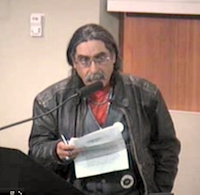
My name is LeRoy Cisneros. I thank you for letting me speak, and I want to speak in a respectful way.
I’m concerned with the easement and the whole process that’s going on. The easement, everybody’s talking about an easement, some people say 15 acres…I’m concerned that the easement that is being talked about might end up like what happened at the shopping center [Bay Street Mall] and shellmound site… the biggest shellmound site in the Bay Area, in Emeryville.
Over there, there was an agreement, and now [the shellmound was completely paved over, and] there’s a little [fake] mound about ten feet high, its a little grassy hill with a little stone that says “this marks an ancient shellmound site”. To me that is not an easement. And I’m hoping that’s not the direction this is going to.
The process…I’m looking at that closed session. I’m concerned with the Brown Act and Sunshine Law. “Closed Session…Under Negotiation: Price and Terms of Payment”. This tells me that, I guess, the agreement has already been made? I’d like to know what that agreement is, we’d like to know. We’d like to know what’s been going on, instead of after the fact. Again, I’m concerned about the Sunshine Law and the Brown Act, and I just want to bring that to your attention. Thank you.
Michelle Steinberg, Protect Glen Cove Committee Volunteer
Transcription
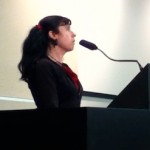
Mayor, Vice Mayor, and councilpeople: thank you for the opportunity to address you. My name is Michelle Steinberg. I’ve been present since the beginning of the vigil that happened more than 12 weeks ago.
I want to respectfully start by addressing what the homeowner mentioned earlier. Every day, we see people walking their dogs, bringing their families, fishermen coming through. We have a friendly relationship with these people. In the very few instances when we have encountered neighbors whose schedules conflict with our presence there, when they respectfully come and address us, we’ve changed our orientation to being in that space. We’ve stopped drumming after certain hours, we’ve even stopped drumming on entire days, because we know that a neighbor very close by there, she works nights. We’ve made all kinds of accommodations, when we’re addressed directly.
We welcome people in the neighborhood coming to visit the site. We are always willing to give them tours of all of the area, and explain what is culturally sensitive there. And so, I beg to disagree with the characterization that anything we are doing there is without respect. Because we are there in profound respect for both the land, and all of the inhabitants.
I want to go on to say that, you know, Corrina [Gould] mentioned earlier, the importance of all 15 acres. I’ve had the opportunity in the last weeks to speak with a number of archaeologists. Its been part of my work there to reach out to the archeologists and get try and get a sense of understanding what work has been done in the past there, and what work might be done to clarify some of the issues at this point. And I want to say that I’ve heard from countless different archeologists, people in the profession, people that are willing to come out and do work there to further clarify, that the entire 15 acres contains burial remains. We’ve had neighbors coming in and saying that over the past years they’ve dug up artifacts, including bodies, in their backyards.
This is something that we have to address if we’re talking about a cultural easement. Because an easement that only protects part of the site is not doing justice to our responsibility of respecting that this is a sacred place, and a burial site.
And I think that we have to remember that all of us, who are not California Native people, we are all visitors on this land. And at this point, so much has been taken, and so many of the shellmounds have been destroyed and built over and constructed over, that the least we can do is approach this with treading as light as possible, and in the most respectful way. And the way to do that is to have no parking lots, no bathrooms, and no grading.
The grading in particular, is straight-up digging in to a place where artifacts have been found. And you know, we asked the city council to offer the opportunity for that information to come across your desks so you can see as well as we have that the entire area is part of the sacred site. So, there can be no lip service to protecting and preserving, if it does not include all 15 acres. Thank you.
Mark Anquoe, Kiowa Tribe
Transcription
My name is Mark Anquoe, I’m a resident of San Francisco. …to bring the voice of the Ohlone people, any of the Ohlone people, in to the discussion of what to do with their ancestral land. Or, for that matter, any of the other tribes who have historical ties to the land. And it seems like the tribes that the city has chosen to work with have been hand picked, maybe for their political beliefs or their economic circumstances, I can only speculate.
But regardless, I think it is critical that the city does go with the cultural easement plan. I think it’s important that this is affirmed, so that Native people have a voice in to what happens to their own legacy, to their own history. I think that has been overlooked up to this point.
And in regards to the general morality of the situation, I think it’s easy to understand — I think that most people understand — the fact that the neighbors in the Glen Cove area, the residents, have been the ones predominantly supplying us with food. You know, I think that speaks a lot as to whether or not the neighborhood supports us, or whether or not we have been a nuisance. The fact is, they are our primary supporters at this time.
Lastly, I would just like to maybe try to put this in to a little bit of perspective, because Native history is so often seen as disposable. You know, when the Taliban destroyed the Buddhist statues in Afghanistan, the entire world was shocked, because history, human history, is something that is considered sacred. This is the human history of California, and it should be considered just as sacred as Stonehenge, or the pyramids, or any other ancient human burial site. Thank you.
Osby Davis, Mayor of Vallejo (audio)
The only response from councilmembers to the numerous speakers who addressed the Glen Cove issue came from Mayor Osby Davis, in reply to Glen Cove resident Karol Heppe. Ms. Heppe was the one person who spoke in an angry tone about the vigil at Sogorea Te, demanding that the City enforce its park ordinances upon she called a “tent city” occupied by a “unlawful band of people”. The Mayor’s statement was as follows:
Thank you Miss Heppe. Let me at least clarify something before the next person comes up. I indicated to you at the last meeting in June, that the Council was working on a plan to resolve this. I didn’t say that I had a plan to do anything. I did say also, um, that we would be trying to get it resolved. Part of the resolution was working on the easement that we’re talking about, and the council has given staff direction, basically, to work on that easement, and if that doesn’t work, than to take whatever action is necessary to enforce the law. And that’s going to, um, go forth, and we hope to have something back, hopefully a full resolution by the 26th of this month. Now, one thing or other is going to happen. We’re either going to have an easement, or we’re going to give staff direction to enforce the law. That’s the bottom line.

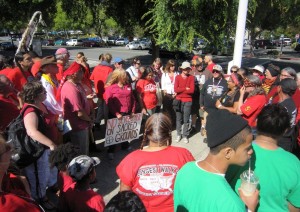
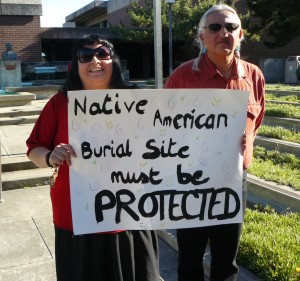
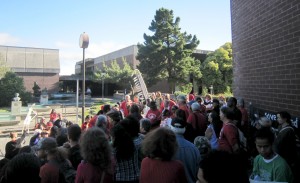
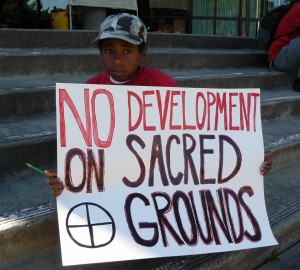
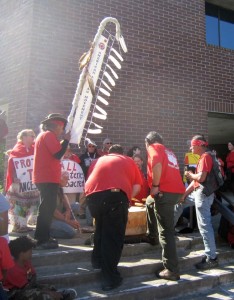
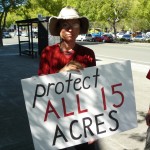
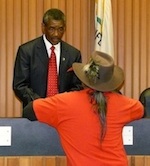
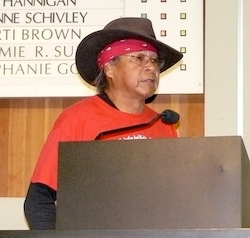

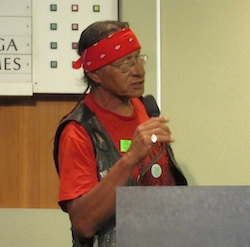
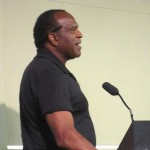
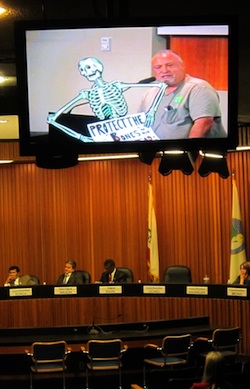
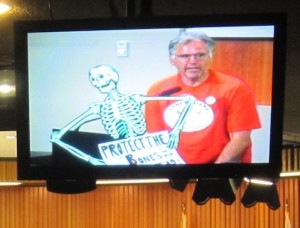
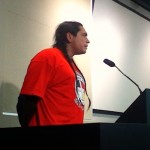
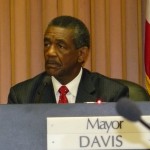
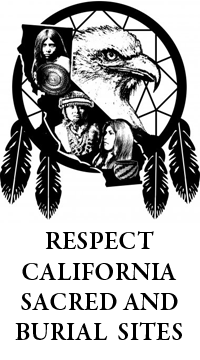


The Indian burial site is behind my house. It is important for the leaders in city of Vallejo know that there are people living in Glen Cove who agree with the Native American cause to protect this land. Many residents welcome their presence & support the protest. The sound of the drumming reminds us that living in this beautiful historical spot is an honor. They have been respectful, good neighbors.
On a practical note- I watch strangers enter and leave. Those who drive here park on Whitesides Dr.
There is more parking available than is ever needed. For hikers, the bathroom in Benicia State Park is closer to us than it is to those who enter from the State Park parking lot!! There is absolutely NO NEED. Why build what is not at all needed here? There are those of us who believe it will invite trouble. Look at the police records to see the number of calls they have gotten over 20 yrs. with teens and crimes. Just because the grant money is there, does not mean it must be used for something that is going to be useless and will ruin a historical site.
We pay our respects to all the Active Warriors on the stand-in. We are over here at another site preparing for the same. We send PRAYERS of change and good energy.
A Village site is just that, a site that was lived on occupied and prepared for another Generation. The relocation and dislocation of this Turtle Island as we know it, was a huge LAW passed design to erase and remove indigenous, aboriginal peoples from their land.
As I sit here in this space of knowledge in the Genealogy department of a prominent research Library, I look around at all the time the Europeans gave them selves to settle here. The Land Lotteries speak for them selves. Mayflower and other Ship after ship brought refugees here to Land that was and still is inhabited. The best the “Americans” can do now is to create alliances with the “Wisdom Keepers” and Medicine Bundles. The Oral Traditional Stories speak volumes of the Heritage and Resources left here by the ancestors and descendants.
R.Quetzal Quinnones ndnmediaSOULJA
THANK YOU TO MY BROTHER AND SISTERS TAKING THE TIME TO DO A STAND IN. IT IS A BENEFIT TO ALL WHO CALL THIS LAND THEIR “HOME”.
Pingback: The Wild Hunt » Pagan Chaplain Speaks Out on Native Sacred Lands, Heads to Amman, Jordan for Cross-Cultural Dialog Conference